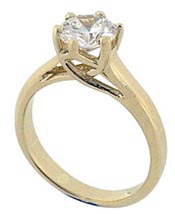![]()
![]()
![]()
![]()
![]()
![]()
![]()
![]()
![]()
![]()
How to Buy a Diamond Engagement Ring She'll Fall in Love WithTutorial Getting Started With Diamond Color
1.02 Carat Diamond Solitaire in Yellow
Gold Prong Setting
An Exclusive Design of Sun Jewelry, © Sun
Jewelry
Get StartedGet started by exploring The Four C's: color, clarity, cut, and carat weight, characteristics that contribute to a diamond's beauty and value. As you move through the tutorials, remember that no one diamond is "best" for everyone. The Four C's are like a diamond pizza--every ingredient is important, but they all support each other. You'll learn to change the ingredients to come up with the right diamond. Tutorials Tip: It's easy to work through the tutorials by keeping this document on your desktop and opening links in a new window. PC users can right-click, Mac users can hold down the mouse button and wait for the prompt. Diamond ColorYou might be surprised to learn that most diamonds are not truly colorless. How To Evaluate Diamond Color explains the GIA's diamond grading scale and helps you select a color grade for your diamond engagement ring.Fluorescence is a characteristic that makes some diamonds appear to change color when they are exposed to ultraviolet light. Learn How Fluorescence Affects Color so that you aren't surprised when she wears her diamond in different lighting situations. Some diamonds are treated to improve their color--and some treatments aren't permanent. Diamond Color Treatments provides the details. Diamond ClarityClarity is a term that's used to describe the clearness of a diamond. A perfect diamond with perfect clarity is rare, and most flaws that exist in jewelry grade diamonds cannot be seen without looking at them through a jeweler's magnifying loupe. It's important to understand diamond clarity before you shop for an engagement ring, so that you can make sense of the jeweler's explanations--and so that you don't get too exited about the word flaws or other terms used to describe the tiny imperfections in diamonds. Diamond CutThe term diamond cut does not refer to a diamond's shape. It describes the diamond's proportions, such as its depth and width and the uniformity of its facets--all characteristics that control brilliance, durability and other features we look for in a quality diamond. A good cut is essential to a diamond's beauty. If the cut is of poor proportions, even a diamond with outstanding color and clarity will not display the sparkle that diamonds are famous for, because the gemstone's components cannot interact with light as they should. Prong SettingsThe prong setting, sometimes called a claw setting, is the most commonly used gemstone setting. You see them all the time--the diamond is inserted into three or more metal prongs that form a basket-like base, then the ends of the prongs are shaped to hold the gemstone snugly in place. |
![]()
![]()
© Copyright 2010 Bahlsen-cielo.com All rights reserved.
Unauthorized
duplication in part or whole strictly prohibited by international copyright
law.
![]()
